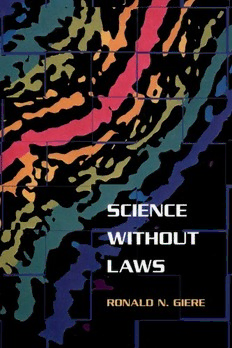Table Of ContentSCIENCE
WITHOUT
LAWS
SCIENCE AND ITS CONCEPTUAL FOUNDATIONS
A SERIES EDITED BY DAVID L. HULL
SCIENCE
WITHOUT
LAWS
RONALD N.
GIERE
THE UNIVERSITY OF CHICAGO PRESS
CHICAGO AND LONDON
Ronald N. Giere is professor of philosophy at the University of Minnesota and
a former director of the Minnesota Center for Philosophy ofScience. His books
include Understanding Scientific Reasoning and Explaining Science: A Cognitive
Approach, the latter published by the University of Chicago.
The University of Chicago Press, Chicago 60637
The University of Chicago Press, Ltd., London
© 1999 by The University of Chicago
All rights reserved. Published 1999
08 07 06 05 04 03 02 01 00 99 5 4 3 2 1
ISBN (cloth): 0-226-29208-8
Library of Congress Cataloging-in-Publication Data
Giere, Ronald N.
Science without laws I Ronald N. Giere.
p. em.-(Science and its conceptual foundations)
ISBN 0-226-29208-8 (alk. paper)
1. Science-Philosophy. 2. Realism. I. Title. II. Series.
Q175.G48898 1999
501-dc21
98-46904
CIP
@ The paper used in this publication meets the minimum requirements of the
American National Standard for Information Sciences-Permanence of Paper for
Printed Library Materials, ANSI Z39.48-1992.
For my mother,
Helen Agnes Marusa,
and in memory of my father,
Silas Irving Giere
Contents
Acknowledgments ix
Introduction
The Science Wars in Perspective
PART ONE
PERSPECTIVES ON SCIENCE STUDIES
ONE Viewing Science 11
TWO Explaining Scientific Revolutions 30
THREE Science and Technology Studies 56
PART TWO
PERSPECTIVES ON SCIENCE
FOUR Naturalism and Realism 69
FIVE Science without Laws of Nature 84
SIX The Cognitive Structure of Scientific Theories 97
SEVEN Visual Models and Scientific Judgment 118
vii
I
viii CONTENTS
PART THREE
PERSPECTIVES ON THE PHILOSOPHY OF SCIENCE
Introduction 149
EIGHT Philosophy of Science Naturalized 151
NINE Constructive Realism 174
TEN The Feminism Question in the Philosophy
of Science 200
ELEVEN From Wissenschaftliche Philosophic to Philosophy
of Science 217
Conclusion
Underdetermination, Relativism, and
Perspectival Realism 237
Notes 243
References 263
Index 281
Acknowledgments
This volume owes much to numerous individuals and to several
institutions. For general support and encouragement, I thank Paul
and Patti Churchland, Arthur Fine, Bas van Fraassen,Jim Griesemer,
Stephen Kellert, Philip Kitcher, Nancy Nersessian, Michael Ruse,
Fred Suppe, and especially Paul Teller. I thank also my colleagues at
the Minnesota Center for Philosophy of Science, John Beatty, Wade
Savage, and Ken Waters. For help with my excursions into the his
tory of Logical Empiricism I am indebted to Rick Creath, Michael
Friedman, and Alan Richardson. Helen Longino, Lynn Nelson, and
Naomi Scheman encouraged my interests in feminist theory. Tom
Gieryn and Karin Knorr-Cetina continue to provide advice on cur
rent movements in the sociology of science. Special thanks go the
series editor, David Hull, and to Susan Abrams, Executive Editor at
the University of Chicago Press. Steve Lelchuk prepared most oft he
diagrams and helped in numerous other ways. Finally, of course, I
am indebted to my wife, Barbara Hanawalt, for her encouragement
in all things.
While preparing this manuscript, I enjoyed the support of the
National Science Foundation and the National Endowment for the
Humanities. The staffa nd Fellows oft he National Humanities Center
lx
I
X ACKNOWLEDGMENTS
provided both intellectual stimulation and moral support through
out the 1997-98 academic year. I will remember them all with great
affection for many years to come.
All but one of these essays (chapter 4, "Naturalism and Realism")
have been previously published, and all but two within the past five
years. For this presentation, they have been edited to remove overlaps
and update references. No effort has been made to preserve their
integrity as historical documents. I regard them as contributions
to an ongoing contemporary debate. Here presented by permission,
they first appeared as follows: Chapter 1, "Viewing Science," in
PSA 94, vol. 2, Proceedings of the 1994 Biennial Meeting of the Phi
losophy of Science Association, ed. R. Burian and M. Forbes, 3-16
(East Lansing: The Philosophy ofScience Association, 1995). Chap
ter 2, "Explaining Scientific Revolutions," in Issues and Images in the
Philosophy of Science, ed. D. Ginev and R. S. Cohen, 63-86 (Boston:
Kluwer, 1997). Chapter 3, "Science and Technology Studies: Pros
pects for an Enlightened Post-Modem Synthesis," Science, Technology,
and Human Values 18: 102-12 (1993). Chapter 5, "Science Without
Laws of Nature," in Laws of Nature, ed. F. Weinert, 120-38 (New
York: Walter de Gruyter, 1995). Chapter 6, "The Cognitive Struc
ture of Scientific Theories," Philosophy of Science 61:276-96 (1994).
Chapter 7, "Visual Models and Scientific Judgment," in Picturing
Knowledge: Historical and Philosophical Problems Concerning the Use of
Art in Science, ed. B. S. Baigrie, 269-302 (Toronto: University of
Toronto Press, 1996). Chapter 8, "Philosophy of Science Natural
ized," Philosophy of Science 52: 331-56 (1985). Chapter 9, "Con
structive Realism," in Images of Science, ed. P. M. Churchland and
C. A. Hooker, 75-98 (Chicago: Umversity ofChicago Press, 1985).
Chapter 10, "The Feminism Question in the Philosophy of Sci
ence," in Feminism, Science, and the Philosophy of Science, ed. L. H. Nel
son and J. Nelson, 3-15 (Boston: Kluwer, 1996). Chapter 11, "From
Wissenschaftliche Philosophie to Philosophy of Science," in Origins of
Logical Empiricism, Minnesota Studies in the Philosophy of Science,
vol. XVI, ed. R.N. Giere and A. Richardson, 335-54 (Minneapo
lis: University ofMinnesota Press, 1996).

